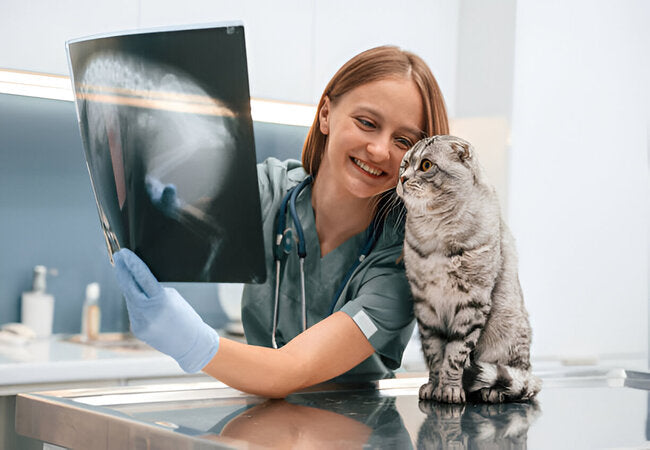Cat X-Rays 2025: Expert Veterinary Guide🩺🐱

In this article
Cat X-Rays 2025: Expert Veterinary Guide🩺🐱
By Dr. Duncan Houston BVSc
Hello! I’m Dr Duncan Houston BVSc, veterinarian and founder of Ask A Vet. X-ray imaging is one of the most valuable diagnostic tools in feline medicine—it offers quick, non-invasive insight into bones, lungs, abdomen, dental structures, and more. In this detailed 2025 guide, I’ll walk you through when cat x-rays are needed, what they cost, how the procedure works, sedation and safety, potential risks, advanced imaging options, and tips for care and cost savings.
1. 📍 When Are Cat X‑Rays Indicated?
Cat x‑rays are commonly used for:
- Suspected fractures or trauma—limping, swelling, pain & emergency care.
- Respiratory issues: Coughing, difficulty breathing, suspected asthma, pneumonia or heart enlargement.
- Gastrointestinal concerns: Vomiting, foreign body ingestion, abdominal distention.
- Urinary signs: Straining, blood in urine—useful for detecting bladder or kidney stones.
- Spinal issues: Suspected disc disease or spinal malformations.
- Dental evaluations: Root infections or hidden tooth problems.
- Screening for masses or cancers: Radiographs reveal tumors or organ masses.
- Pregnancy assessment: Later-term x-rays to count kittens or evaluate dystocia risk.
2. 💵 Cost Breakdown – What You’ll Pay in 2025
| Type of X‑ray | Cost per image (USD) |
|---|---|
| Abdominal | $100 – 250 |
| Chest | $150 – 250 |
| Limb or dental | $75 – 150 (dental $40–125) |
| Spinal or full‑body | $150 – 350 |
Each additional view may be discounted. These costs reflect recent surveys from VETY, Catster, Vety.com, and PetInsuranceReview.
3. 🩺 Sedation & Positioning Considerations
- Awake vs sedated: Calm cats can stay awake; painful or anxious cats often need mild sedation (adds $100–150) or general anesthesia ($200–400).
- Safety gear: Staff wear lead aprons, gloves, thyroid shields, and dosimeters.
- Fasting: Required before sedation to reduce vomiting risk.
- Positioning: Proper alignment—lying on side, back, or paws—is key; sedation ensures stillness and accuracy.
4. 🧭 The X‑Ray Procedure, Step by Step
- Initial clinical exam and discussion of goals (diagnosis, pain/sedation).
- Fasting prep if needed.
- Placement of IV catheter and monitoring if sedation or anesthesia is used.
- Positioning the cat and capturing 1–4 images depending on the diagnostic need.
- Immediate digital image review for quality.
- Radiologist interpretation may be included or performed by general vet.
- Post-procedure recovery and review of findings with you.
5. ⚠️ Benefits & Limitations of X‑Rays
- Benefits: Quick, non-invasive, painless, and cost-effective for diagnosing bones, organs, and foreign objects.
- Limitations: Limited soft tissue contrast; overlapping structures may blur diagnosis; 2D only.
6. ⚕️ Risks & Safety Precautions
- Radiation exposure: Minimal in occasional use; protective gear shields staff; owners usually not present.
- Sedation risks: Rare but higher with poor health; bloodwork helps assess suitability.
- Positioning harm: Misalignment could stress injured limbs—results reviewed immediately.
7. 🧠 When to Choose Advanced Imaging
If x‑rays are inconclusive, your vet may recommend:
- Ultrasound: Soft-tissue detail in abdomen or heart ($300–600).
- CT scan: Bone, sinus, or lung detail; costs $500–1,500.
- MRI: Brain, spinal cord imaging; $1,500–6,000 depending on facility.
- Fluoroscopy: Real-time imaging for swallowing function ($300–800).
8. 💡 Tips to Save Costs
- Compare clinic and emergency vs regular rates—urban areas may charge more.
- Get package pricing on multiple views.
- Use veterinary teaching hospitals or low-cost clinics.
- Utilize pet insurance—diagnostic imaging often covered under illness/accident plans.
- Ask for digital images to avoid retakes and share with specialists.
9. 🧩 Ask A Vet, Woopf & Purrz Support
- Ask A Vet: Telehealth consults help you determine if x‑rays are needed and prep advice for sedation or fasting.
10. ✅ Final Thoughts
X‑rays are essential diagnostics in feline medicine—fast, informative, and often cost-effective. In 2025, expect $100–250 per view, with sedation and facility type affecting the final cost. Always choose professional imaging, adhere to sedation guidelines, and consider advanced imaging when necessary. With tools like Ask A Vet, you have access to expert guidance and essential care gear. Stay vigilant, stay informed—and let’s ensure your cat gets the best internal insight possible! 🐾💙






